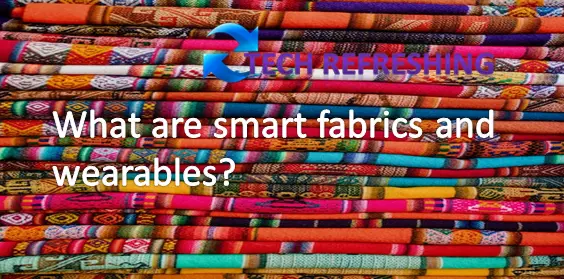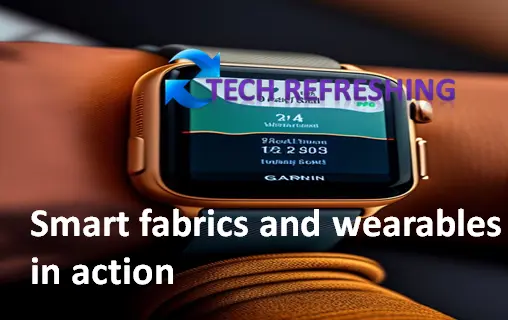The fashion sector has long been acknowledged for leading the way in trends and advancements, persistently adapting to fulfill the demands and preferences of consumers. With the emergence of modern materials, production methods, and retail encounters, technology has become progressively crucial in the fashion industry during recent times.
One of the most exciting developments in the intersection of fashion and technology is the use of smart fabrics and wearables. Smart fabrics are textiles that have sensors, electronics and other components woven into them so they can track changes in the body or environment of the wearer and react accordingly. Contrarily, wearables are electronic devices that are worn on the body and have a variety of uses, including fitness tracking, health monitoring and notification systems.
Together, smart fabrics and wearables offer a range of exciting possibilities for the fashion industry. They can enhance the functionality of clothing, allowing for greater comfort, convenience, and safety. They can also provide new ways for consumers to express themselves and interact with their clothing.
This blog article will delve into how artificial intelligence is revolutionizing the fashion industry through the implementation of smart fabrics and wearables. It will outline the advantages of incorporating AI in fashion design through the use of these intelligent materials and accessories and provide instances of AI-driven smart fabrics and wearables in fashion. Additionally, the challenges and factors to be mindful of when using these technologies will be explored, along with a look into the future of this dynamic convergence of fashion and technology.
What are Smart Fabrics and Wearables?

Smart fabrics and wearables are two technologies that are transforming the fashion industry. Let’s take a closer look at each of them:
Smart Fabrics:
Smart fabrics are textiles that are embedded with technology such as sensors, electronics or other components that allow them to respond to changes in the wearer’s environment or body. These fabrics can be programmed to sense and react to various stimuli, including temperature, light, motion or sound.
Some examples of smart fabrics include:
- Conductive fabrics: These materials have conductive threads that make them suitable for use as touch sensors, allowing clothes to react to commands given by touch.
- Fabrics with shape memory: These materials can adapt to changes in temperature or other environmental conditions by changing their shape. They can be used to design adaptive clothing that conforms to the needs or preferences of the wearer.
- Thermochromic fabrics: Textiles that change colour in response to temperature variations can produce a variety of visual effects.
Wearables:
Wearables are electronic devices that can be worn on the body and can perform a range of functions, such as tracking fitness, monitoring health or providing notifications. They are often integrated with smart fabrics to create functional and stylish clothing items.
Some examples of wearables include:
Fitness trackers: These gadgets monitor a user’s heart rate, physical activity, and other biometric data while being worn on the wrist or attached to clothing.
- Fitbit: A reputable company that manufactures a variety of fitness trackers and smartwatches.
- Garmin: A manufacturer of smartwatches and fitness trackers with GPS functionality.
- Xiaomi: A manufacturer of inexpensive fitness trackers, Xiaomi is a Chinese electronics firm.
Smartwatches: Smartwatches have emerged as a multifunctional accessory that can be worn similarly to traditional watches while providing various features such as fitness tracking, music control, and notification alerts. Let’s explore some of the prominent smartwatch brands and their unique features:
- Apple: A renowned name in the smartwatch market, Apple offers the Apple Watch, which is equipped with advanced features like fitness tracking, mobile payments, and notifications for calls, messages, and social media updates.
- Samsung: Another popular brand in the smartwatch market, Samsung’s Galaxy Watch is an Android-based smartwatch with fitness tracking capabilities and mobile payment options, making it a convenient and efficient device for users.
- Garmin: Apart from producing fitness trackers, Garmin also manufactures a range of smartwatches with features such as GPS navigation, music storage, and customizable watch faces, catering to the diverse needs of consumers.
Smart glasses: These glasses contain sensors and displays that can provide the wearer with information or augment their reality.
- Google: Google Glass was an early entrant into the smart glasses market, providing a heads-up display that could show information and respond to voice commands.
- Vuzix: Vuzix produces a range of smart glasses that are designed for industrial use, providing workers with hands-free access to information and instruction.
- North: North produces smart glasses that are designed for everyday use, providing users with information and notifications in a subtle and stylish manner.
Overall, the fashion sector has exciting new opportunities because to smart fabrics and wearables, which enable new levels of functionality and involvement in apparel. These technologies are becoming much more potent and practical as artificial intelligence is integrated with them and in the years to come, we may anticipate even more advancement in this area.
How AI is Making Fashion Smarter with Smart Fabrics and Wearables

Artificial intelligence (AI) is playing an increasingly important role in the fashion industry, particularly when it comes to the development and use of smart fabrics and wearables. Let’s explore some of the ways in which AI is making fashion smarter:
How AI is involved in the design process:
AI is being utilised in the design process to develop fresh concepts and ideas, streamline design workflows and boost manufacturing productivity. In order to provide designers with insights and inspiration, AI-powered software can analyse enormous volumes of data, including social media trends, consumer preferences and historical sales data.
Moreover, design tools fueled by artificial intelligence have facilitated designers to explore various materials, shapes and patterns, resulting in more imaginative and inventive designs. The incorporation of AI enables designers to swiftly generate and modify designs, accelerating the design process and decreasing the time required to launch new products into the market.
The benefits of using AI in fashion design with smart fabrics and wearables:
The integration of AI with smart fabrics and wearables is providing a range of benefits for the fashion industry, including:
- Enhanced functionality: Wearables and smart fabrics powered by AI can provide a variety of functions, including recording biometric data, regulating body temperature, and displaying augmented reality.
- Increased sustainability: By employing eco-friendly materials and cutting waste during production, smart fabrics and wearables can be made to be more sustainable.
- Improved personalization: With the aid of artificial intelligence (AI), smart fabrics and wearables may be customised to the needs and preferences of the wearer, offering a more pleasant and individualised experience.
Examples of AI-powered smart fabrics and wearables in fashion:
Here are some examples of how AI-powered smart fabrics and wearables are being used in the fashion industry:
- Bolt Threads: Bolt Threads is a company that uses AI to develop sustainable materials for use in fashion. They have developed a bioengineered spider silk material that is both durable and eco-friendly.
- Ministry of Supply: Ministry of Supply is a clothing brand that uses AI to design and develop functional and comfortable clothing. Their 3D-knitted dress shirts are designed to regulate temperature and provide a custom fit for each wearer.
- Levi’s: Levi’s has partnered with Google to develop a smart jacket that uses AI-powered touch sensors to allow wearers to control their music and receive notifications without having to pull out their phone.
Ultimately, the fashion industry is being transformed by AI-powered smart fabrics and wearables because they provide new heights of utility, sustainability and customisation. We could expect to see even more fascinating and cutting-edge uses of AI in fashion as technology develops.
Smart Fabrics and Wearables in Action

Applications for smart fabrics and wearables are numerous, ranging from safety and security to tracking fitness and health. Let’s examine some of the applications for smart clothing and wearable technology in various contexts:
Smart fabrics and wearables for fitness and health tracking:
Among the smart fabrics and wearables used for health and fitness tracking, fitness trackers and smartwatches are likely the most familiar. These devices are capable of monitoring various metrics such as the number of steps taken, calories burned and heart rate, furnishing users with valuable information regarding their physical activity and well-being.
Apart from wrist-worn devices, there is a surging trend of smart fabrics and wearables that can be worn on different body parts like the chest or waist. These wearables leverage sensors to monitor biometric data and furnish users with feedback regarding their posture, breathing and muscle activation.
Smart fabrics and wearables for safety and security:
Smart fabrics and wearables have also found their application in improving safety and security in various settings. Several companies are creating smart helmets for cycling and other sports that can detect impacts and notify emergency contacts in case of an accident.
Similarly, some companies are developing smart clothing for use in industrial settings, which can monitor for hazardous conditions and alert workers if there is a safety issue. Smart fabrics and wearables are also being used in military and law enforcement applications, providing soldiers and police officers with enhanced situational awareness and protection.
Smart fabrics and wearables for fashion and self-expression:
Smart materials and wearables can be utilised to develop new styles of clothing and modes of self-expression in addition to serving functional purposes. Smart materials, for instance, are being used by some designers to make clothing that adapts to the wearer’s actions or the surroundings by changing colour or shape.
Also, some businesses are creating smart jewellery and accessories that can be altered to suit the tastes of the wearer. For instance, a smart necklace might light up or change colour in response to specific movements or directions.
Smart fabrics and wearables are extensively employed across diverse domains, including augmenting fitness and health tracking, elevating safety and security, and enabling novel modes of fashion and self-expression. With the continued progression of technology, we can anticipate witnessing further enthralling and innovative uses of smart fabrics and wearables in the forthcoming years.
Challenges and Considerations

While smart fabrics and wearables have the potential to revolutionize the fashion industry, there are also several challenges and considerations that must be taken into account:
Ethical considerations of collecting and using personal data through wearables:
The quantity of personal data that wearables gather and the uses to which those data are put are two of the main worries. Fitness trackers, for instance, gather information about a user’s movement patterns and biometrics, as can smart clothing items. Fitness trackers also gather information on a user’s heart rate and sleep patterns.
The data obtained from wearables can be employed to enhance product design and tailored marketing, yet it can also be utilized in manners that present ethical apprehensions. For instance, certain wearables have been incorporated into workplace wellness programs that encourage employees to disclose personal health information, thereby heightening concerns over data privacy and discrimination.
Challenges in creating truly smart and functional smart fabrics and wearables:
Creating smart fabrics and wearables that are both stylish and functional can be a significant challenge. For example, smart clothing must be comfortable, durable, and easy to care for, while also incorporating sensors, processors and batteries.
Moreover, considerable advancements in sensor and material science, as well as AI and machine learning algorithms, are needed to develop smart fabrics and wearables that are truly smart and practical. It can be challenging to strike a balance between these technological factors and the requirement to produce items that are wearable and have a pleasing appearance.
Balancing style with functionality and practicality:
Smart fabrics and wearables must strike a balance between style and utility. Despite the burgeoning demand for wearable technology that mimics conventional clothing and accessories in appearance and texture, accomplishing this feat without compromising functionality and practicality can be challenging.
For example, smart clothing that incorporates LED lights or other embellishments may be eye-catching, but it can also be heavy, uncomfortable, and difficult to clean. Balancing these competing considerations is an ongoing challenge for designers and manufacturers of smart fabrics and wearables.
The utilization of smart fabrics and wearables has the capacity to revolutionize the fashion industry. However, there exist numerous challenges and factors that must be deliberated. From apprehensions over data privacy and security to the technical hurdles involved in producing genuinely smart and practical products, designers and manufacturers of smart fabrics and wearables must thoughtfully balance various competing elements to develop products that are both fashionable and functional.
Conclusion
Smart fabrics and wearables are poised to transform the fashion industry in significant ways, and AI is playing a crucial role in enabling these innovations. By incorporating sensors, processors and other advanced technologies, smart fabrics and wearables can provide a range of benefits, including improved fitness and health tracking, enhanced safety and security and new opportunities for self-expression and personalization.
There are also important obstacles and factors that must be taken into account at the same time. Designers and manufacturers of smart fabrics and wearables must manage a range of complicated issues to build goods that are both fashionable and useful, from ethical considerations around data privacy and security to technical challenges in creating really smart and functioning items.
In the future, it appears probable that technology will assume an even more significant role in the fashion industry. With the emergence of AI-powered design tools and smart fabrics and wearables that integrate advanced sensors and processors, we can anticipate a plethora of new advancements that will revolutionize our perspective on fashion and wearables.
Ultimately, the key to success in this rapidly evolving field will be the ability to balance technical innovation with aesthetic appeal and practical functionality, creating products that are both innovative and wearable. As designers and manufacturers continue to push the boundaries of what is possible with smart fabrics and wearables, we can expect to see an exciting new era of fashion innovation and experimentation in the years to come.



Comments are closed.